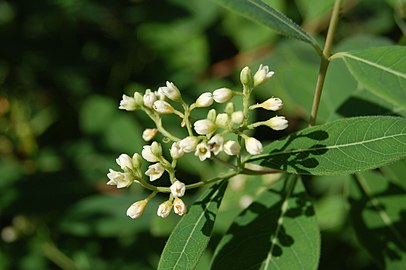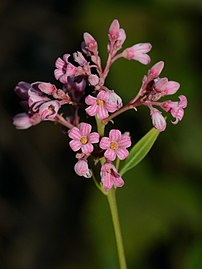Apocynum
| Apocynum | |
|---|---|

| |
| Apocynum androsaemifolium | |
| Scientific classification | |
| Kingdom: | Plantae |
| Clade: | Tracheophytes |
| Clade: | Angiosperms |
| Clade: | Eudicots |
| Clade: | Asterids |
| Order: | Gentianales |
| Family: | Apocynaceae |
| Subfamily: | Apocynoideae |
| Tribe: | Apocyneae |
| Genus: | Apocynum L. |
| Synonyms[1] | |
| |
Apocynum, commonly known as dogbane[2] or Indian hemp,[2] is a small genus of the flowering plant family Apocynaceae. Its name comes from Ancient Greek ἀπόκυνον apókunon, from ἀπο- apo- "away" and κύων kúōn "dog",[3] referring to dogbane (Cionura erecta),[4] which was used to poison dogs.[5] The genus is native to North America, temperate Asia, and southeastern Europe.[1][6][7]
Apocynum species are used as food plants by the larvae of some Lepidoptera species, including the mouse moth and the queen butterfly.
Uses
[edit]Apocynum cannabinum is used as a source of fiber by Native Americans. Apocynum venetum (Chinese: 羅布麻) is used as an herbal tea in China.[8] Dogbane contains cymarin, a cardiotonic agent formerly used to treat cardiac arrhythmia in humans.[9]
Species
[edit]Almost 300 names have been proposed in the genus for species, subspecies, and forms.[1] As of 2019[update], only the following five species and hybrids are currently recognized, with several subspecies and varieties accepted for A. androsaemifolium and A. venetum (see their respective species pages).[10]
- Apocynum androsaemifolium L. – Canada, United States, northeastern Mexico
- Apocynum cannabinum L. – Canada, United States
- Apocynum × floribundum Greene (a hybrid of A. androsaemifolium and A. cannabinum) – Canada, United States, northern Mexico
- Apocynum pictum Schrenk – China, Mongolia, Kazakhstan, Kyrgyzstan, Tajikistan
- Apocynum venetum L. – southeastern Europe and Asia
-
Flowers of Apocynum cannabinum
-
Leaves of Apocynum androsaemifolium
References
[edit]- ^ a b c "Apocynum". World Checklist of Selected Plant Families (WCSP). Royal Botanic Gardens, Kew. Retrieved May 21, 2014.
- ^ a b English Names for Korean Native Plants (PDF). Pocheon: Korea National Arboretum. 2015. p. 517. ISBN 978-89-97450-98-5. Archived from the original (PDF) on 25 May 2017. Retrieved 25 January 2016 – via Korea Forest Service.
- ^ http://www.co.jefferson.co.us/coopext/plantdetail.do?sna=Apocynum+androsaemifolium&image=0 Archived 2011-07-27 at the Wayback Machine Colorado Plant Database
- ^ ἀπόκυνον in Liddell, Henry George; Scott, Robert (1940) A Greek–English Lexicon, revised and augmented throughout by Jones, Sir Henry Stuart, with the assistance of McKenzie, Roderick. Oxford: Clarendon Press. In the Perseus Digital Library, Tufts University.
- ^ Dempster, Lauramay T. (1993). "Apocynum". In Hickman, James C. (ed.). The Jepson Manual: Higher Plants of California. University and Jepson Herbaria.
- ^ Li, Bingtao; Leeuwenberg, Antony J. M.; Middleton, David J. "Apocynum". Flora of China. Vol. 16 – via eFloras.org, Missouri Botanical Garden, St. Louis, MO & Harvard University Herbaria, Cambridge, MA.
- ^ "Apocynum". County-level distribution maps from the North American Plant Atlas (NAPA). Biota of North America Program (BONAP). 2013.
- ^ Xiong, Q; Fan, W; Tezuka, Y; Adnyana, IK; Stampoulis, P; Hattori, M; Namba, T; Kadota, S (2000). "Hepatoprotective effect of Apocynum venetum and its active constituents". Planta Med. 66 (2): 127–33. doi:10.1055/s-2000-11135. PMID 10763585. S2CID 25960011.
- ^ National Center for Biotechnology Information, U.S. National Library of Medicine, Cymarine
- ^ "Apocynum L." Plants of the World Online. Royal Botanical Gardens Kew. Retrieved 17 June 2019.
External links
[edit] Media related to Apocynum at Wikimedia Commons
Media related to Apocynum at Wikimedia Commons



